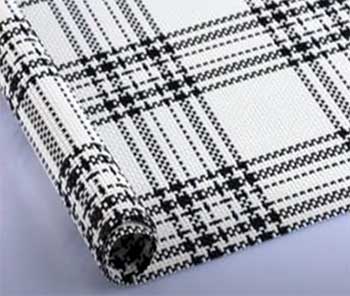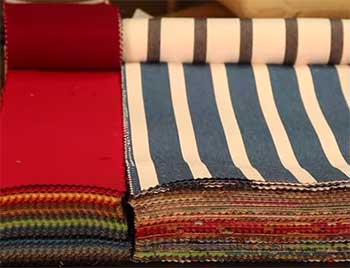Outdoor fabrics like Textilene and Sunbrella have become increasingly popular for making patio furniture, boat covers, cushions, and more. But with so many options on the market, it can be tough to decide which fabric is right for your needs.
In this guide, we’ll compare Textilene and Sunbrella head-to-head – looking at durability, weather resistance, cost, feel, and more. By the end, you’ll have all the information you need to choose the best outdoor fabric for your project.
A Brief Comparison Table
| Factor | Textilene | Sunbrella |
| Durability | Good | Excellent |
| Tear strength | Moderate | Very high |
| Fade resistance | 1-3 years | 5-10+ years |
| Water resistance | Good | Excellent |
| Stain resistance | Moderate | Excellent |
| Mildew resistance | Good | Excellent |
| Texture | Canvas-like | Stiff, papery |
| Drape | Excellent | Moderate |
| Care | Easy | Easy |
| Feel | Soft, pliable | Stiff but softens over time |
| Uses | Casual furniture, accessories | Premium furniture, marine covers |
Overview of Textilene Fabric
Textilene is a woven polyester fabric that is designed to be durable, water resistant, and protective against UV rays. It has a similar look and feel to canvas, with a slightly coarse texture that softens over time.
Some key properties of Textilene include:

- Water resistant – Textilene is coated with a water repellent finish that causes water to bead up and roll off the fabric. It’s great for light rain and moisture protection.
- Mold/mildew resistant – The polyester material won’t rot or mildew, even with moisture exposure.
- UV resistant – Textilene is treated to block harmful UV rays and prevent sun damage/fading. The level of UV resistance depends on the specific type of Textilene.
- Durable and strong – The woven construction makes Textilene stronger and longer-lasting than other polyester fabrics. It stands up well to abrasion and tearing.
- Breathable – Textilene allows air flow through the fabric weave, preventing condensation build up. This makes it more comfortable for cushions/upholstery.
- Easy to clean – You can clean Textilene with soap and water using a sponge or soft brush. It can also be power washed on a gentle setting.
Overall, Textilene offers good durability at an affordable price point. It’s a reliable choice for basic outdoor furniture covers, shade sails, and other projects needing a water resistant polyester fabric. The main downside is that it’s not quite as strong or fade/stain resistant as premium alternatives like Sunbrella.
Overview of Sunbrella Fabric
Sunbrella is one of the most popular and recognizable performance fabrics on the market. It’s made from 100% solution-dyed acrylic that is designed for heavy-duty outdoor use.
Here are some of the notable features and benefits of Sunbrella fabric:
- Extremely fade resistant – Sunbrella retains its color and vibrancy even after years in the sun. The solution-dyeing process means the color pigment penetrates all the way through the fibers.
- Water and stain resistant – Sunbrella has a durable water repellent (DWR) finish that prevents absorption. Liquids bead up and can be brushed off before staining.
- Durable and tearing resistant – Acrylic fibers are very strong and durable. Sunbrella stands up well to abrasion, tearing, and punctures compared to other fabric types.
- Mildew and rot resistant – Sunbrella doesn’t absorb moisture and won’t promote growth of mold or mildew.
- Breathable – The tight acrylic weave allows air flow while blocking liquids. This prevents condensation build up.
- Easy to clean – You can clean Sunbrella with soap and water or bleach it for tougher stains. It can be machine washed in cold water.
The biggest downside to Sunbrella is the premium price – it costs significantly more than Textilene. However, the exceptional durability and fade resistance make it a worthwhile investment for outdoor furniture and shade structures meant to last 5-10+ years.
Key Differences Between Textilene And Sunbrella Fabrics
Comparing Durability
Durability is a major consideration when choosing an outdoor fabric. You want something that can withstand sun, wind, rain, and everyday wear-and-tear without falling apart.
Both Textilene and Sunbrella score well when it comes to durability, but Sunbrella is the clear winner overall. Here’s how they compare:
- Abrasion resistance – Sunbrella holds up better against rubbing and friction that can cause wear and tear over time. The dense acrylic weave resists pilling or forming thin spots.
- Tear strength – Sunbrella requires much more force to tear than Textilene and most other fabric types. This makes it very resistant to ripping, punctures, and damage from pets.
- Resilience – Sunbrella bounces back after being crushed/wadded up while Textilene may show lasting wrinkles. This helps Sunbrella furniture retain its shape and appearance over years of use.
- Colorfastness – Sunbrella is extremely fade resistant, retaining vibrant colors for 5-10 years depending on sun exposure. Textilene is prone to fading over 1-3 years.
The bottom line is that Sunbrella will outlast Textilene by 2-3 times in terms of longevity and appearance retention. For outdoor items like patio umbrella covers that need to handle wind/rain/sun year-round, the extra durability of Sunbrella can be worth the additional cost.
Weather Resistance Comparison
Weather resistance is key for any outdoor fabric. You want protection from sun, rain, snow, and moisture.
Both Textilene and Sunbrella provide good weather resistance through specialized treatments and finishes. Here’s a detailed comparison:

- Water resistance – Sunbrella and Textilene both have a durable water repellant (DWR) finish that makes water bead up and roll off the fabric. Sunbrella may have a slight edge, but both fabrics can handle light rain and moisture very well.
- Stain resistance – Sunbrella is the winner here. The tight acrylic weave makes it very difficult for spills to penetrate or leave stains. Textilene is prone to some staining over time from spills, dirt, pollen, and other environmental factors.
- Mildew/mold resistance – Again, Sunbrella’s acrylic fiber and lack of moisture absorption give it an advantage. Textilene is also mold and mildew resistant thanks to being polyester. But acrylic is more impervious to rot and microbial growth.
- UV resistance – Both fabrics are treated to resist UV damage and fading. However, Sunbrella holds up to sun exposure significantly better over the long term.
For rainy, humid, or snowy climates, Sunbrella may be worth the investment to get superior weathering performance. But Textilene still provides decent protection from the elements at a more affordable cost.
Appearance and Feel
When choosing a fabric, aesthetic factors like appearance, color/pattern options, and feel are also important considerations.
Here’s how Sunbrella and Textilene compare in looks and feel:
- Look – Sunbrella has a bit more of a smooth, refined appearance while Textilene looks more casual and canvas-like. Sunbrella comes in a wider range of color/pattern options whereas Textilene tends to be limited to basic solids and stripes.
- Texture – Textilene has a soft, pliable hand similar to canvas that conforms well to cushions. Sunbrella has a stiffer, thicker feel that softens over time. Sunbrella may feel a bit “crunchier” or more papery straight out of the package.
- Drape – Due to its lighter weight and looser weave, Textilene generally has a nicer drape and will conform to furniture frames more easily compared to Sunbrella.
- Comfort – For upholstery use, many people prefer the softer, more cloth-like feel of Textilene over Sunbrella’s stiffer hand. But Sunbrella does soften up after some use.
Neither fabric is inherently better looking – it depends on your preferences and project vision. But Sunbrella offers a wider range of colors and patterns to choose from.
Cost Comparison
One of the biggest differences between these two fabrics is cost. Sunbrella commands a significant price premium over Textilene.
Some average price ranges:
- Textilene – $8-$20 per yard for solid colors. Stripes and patterns may cost a bit more.
- Sunbrella – $20-$30 per yard for solids. More complex patterns can cost $40+ per yard.
A Sunbrella fabric item will usually cost 2-3X more than Textilene. For a large project like full patio furniture cushions, that can mean hundreds of extra dollars.
However, Sunbrella’s exceptional longevity can justify the price for many buyers – you pay more upfront but won’t have to replace the fabric as often. And for smaller projects, the price difference may be negligible.
Main Pros and Cons of Textilene And Sunbrella Fabrics
To summarize the key differences between the two fabrics:
Textilene Pros:
- More affordable price point
- Soft, canvas-like feel
- Drapes well over cushions
- Good range of basic colors/patterns
Textilene Cons:
- Less durable and fade resistant versus Sunbrella
- Not as water/stain/mildew resistant
- limited high-end color/pattern options
Sunbrella Pros:
- Extremely durable and long-lasting (5-10+ years lifespan)
- Superior water, stain, and UV resistance
- More high-end patterns and color options
- Softens up over time to a flexible feel
Sunbrella Cons:
- Much more expensive (2-3X+ cost of Textilene)
- Stiffer feel out of the package
- Overkill for some low-wear projects
Watch this video to understand why Sunbrella is a good choice.
Recommended Uses
With their differing properties and advantages, Textilene and Sunbrella are each better suited for certain uses:
Textilene works well for:
- Casual outdoor furniture cushions
- Decorative throw pillows
- Drop cloths for painting/crafts
- Budget boat covers and tarps
Sunbrella is ideal for:
- Premium patio furniture cushions
- Permanent shade structures like canopy tops
- Marine boat covers and biminis
- Heavy-duty slipcovers for RVs/boats
- Outdoor drapes and upholstery
For high-wear items like patio umbrella covers, Sunbrella is worth the investment. But for an inexpensive outdoor rug that gets occasional use, Textilene offers good value.
Consider the specific demands of your project and expected lifespan when deciding between the two.
Frequently Asked Questions (FAQ)
The closest fabric comparable to Sunbrella is Outdura. Both are made from solution-dyed acrylic and offer similar performance and feel. Outdura is slightly less expensive but comes in fewer color/pattern options compared to Sunbrella.
Yes, Textilene has weather resistant properties that make it a good option for basic outdoor use. The polyester fabric is coated to repel water, and it resists UV damage, mildew, and rot. It’s comparable to standard canvas in terms of weather resistance.
Textilene is made from polyester. Specifically, it’s a tightly woven, durable polyester fabric that has been treated to create water repellency and UV/mildew resistance. This makes it suitable for outdoor applications.
For certain uses, yes – Sunbrella is significantly more durable, fade resistant, and long-lasting compared to Textilene. But it also costs 2-3 times more. So for projects like occasional-use patio cushions, Textilene provides good value and performance. It depends on your specific needs and budget.
The Bottom Line
When it comes to all-weather outdoor fabric, both Textilene and Sunbrella are great options. They offer good durability and weather resistance at different price points.
For high-end projects where maximum longevity is needed, splurging on Sunbrella pays dividends thanks to extreme fade resistance and tear strength. It’s the Cadillac of outdoor fabrics.
But for more casual use, Textilene offers comparable performance to canvas at a very affordable price point. It excels at basic patio cushions, decorative items, and other projects where excellent value is more important than decades of use.
Consider the demands of your particular application, as well as your budget, and choose the outdoor fabric that meets your needs. With proper care, both Textilene and Sunbrella will provide years of protection from the elements.

